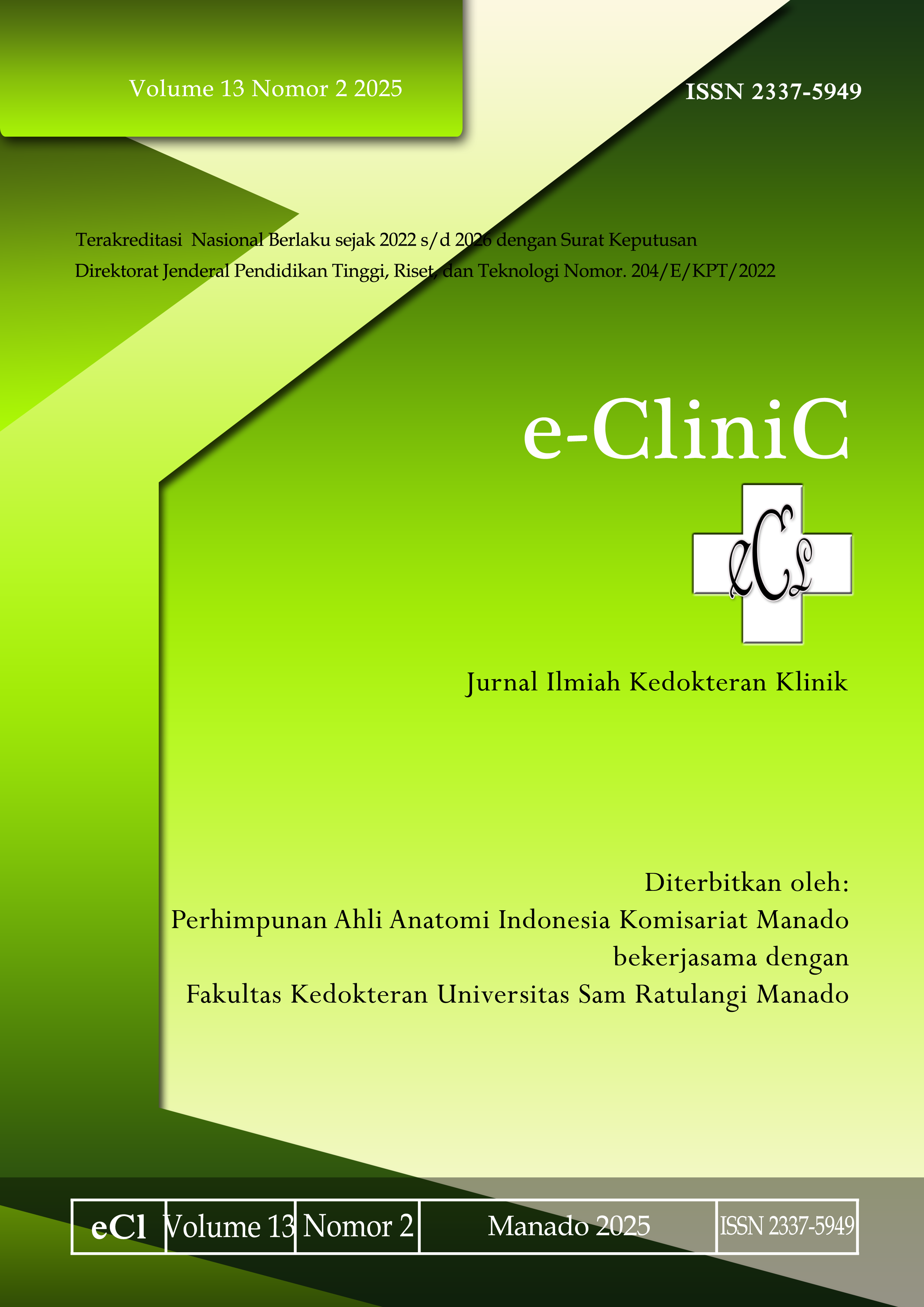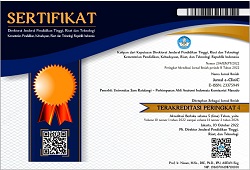Right Ventricular Septal Pacing to Produce Narrow QRS Duration in Patient with High Degree 2:1 AV Block
DOI:
https://doi.org/10.35790/ecl.v13i2.56247Abstract
Prolonged right ventricular (RV) apical pacing has been recognized to be associated with progressive left ventricular (LV) dysfunction. This impairment of LV function resultant from RV apical pacing is a remodelling process consequent to abnormal ventricular activation and contraction. RV septal pacing theoretically is associated with a more physiological ventricular activation results in shorter electrical activation delay and consequently less mechanical dyssynchrony. We reported A-75-year-old woman presented to emergency department (ED) with dyspnea only on exertion in the last 3 weeks before admission, she also complaint near syncope episode while doing activities. Electrocardiogram (ECG) result was high degree AV block with 2:1 conduction with ventricular rate 40 beats per minute. PPM implantation was performed with VVIR mode, ventricle lead inserted into mid-septal RV. ECG post implantation showed pacing rhythm with narrow QRS duration. Pacemaker-related LBBB is associated with an adverse prognosis. RV septal pacing produces more synchronous contraction denoted by narrow QRS, preventing the deterioration of LV structure and function. RV septal pacing, although not as good as intrinsic conduction or His bundle pacing, may be more desirable for chronic RV pacing compared to the RV apex as a narrow QRS is associated with improved LV dynamics. RV septal pacing was safely done in this patient, but further study needed to evaluate its long-term effect.
Keywords: AV block; permanent pacemaker; septal; right ventricle
References
Lamas GA, Lee K, Sweeney M, Leon A, Yee R, Ellenbogen K, et al. The Mode Selection Trial (MOST) in sinus node dysfunction: Design, rationale, and baseline characteristics of the first 1000 patients. Am Heart J. 2000;140(4):541-51. Doi:10.1067/mhj.2000.109652
Sharma AD, Rizo-Patron C, Hallstrom AP, O'Neill GP, Rothbart S, Martins JB, et al. Percent right ventricular pacing predicts outcomes in the DAVID trial. Hear Rhythm. 2005;2(8):830-34. Doi: 10.1016/j.hrthm. 2005.05.015
Mizukami A, Matsue Y, Naruse Y, Kowase S, Kurosaki K, Suzuki M, et al. Implications of right ventricular septal pacing for medium-term prognosis: Propensity-matched analysis. Int J Cardiol. 2016;220:214-18. Doi:10.1016/j.ijcard.2016.06.250
Das A, Kahali D. Ventricular septal pacing: Optimum method to position the lead. Indian Heart J. 2018;70(5):713-20. Doi: 10.1016/j.ihj.2018.01.023
Mond HG. The road to right ventricular septal pacing: Techniques and tools. PACE – Pacing Clin Electrophysiol. 2010; 33(7):888-98. Doi:10.1111/j.1540-8159.2010.02777.x
Burri H, Park C Il, Zimmermann M, Gentil-Baron P, Stettler C, Sunthorn H, et al. Utility of the surface electrocardiogram for confirming right ventricular septal pacing: Validation using electroanatomical mapping. Europace. 2011;13(1):82-6. Doi:10.1093/europace/euq332
Stambler BS, Ellenbogen KA, Zhang X, Porter TR, Xie F, Malik R, et al. Right ventricular outflow versus apical pacing in pacemaker patients with congestive heart failure and atrial fibrillation. J Cardiovasc Electrophysiol. 2003;14(11):1180-6. Doi:10.1046/j.1540-8167.2003.03216.x
Zou C, Song J, Li H, Huang X, Liu Y, Zhao C et al. Right ventricular outflow tract septal pacing is superior to right ventricular apical pacing. J Am Heart Assoc. 2015;4(4):1-7. Doi: 10.1161/JAHA.115.001777.
Kaye GC, Linker NJ, Marwick TH, Pollock L, Graham L, Pouliot E, et al. Effect of right ventricular pacing lead site on left ventricular function in patients with high-grade atrioventricular block: results of the Protect-Pace study. Eur Heart J. 2015;36(14):856-62. Doi:10.1093/eurheartj/ehu304
Worsnick S, Sharma P, Vijayaraman P. Right ventricular septal pacing: a paradigm shift. J Innov Card Rhythm Manag. 2018;9(5):3137-46. Doi: 10.19102/icrm.2018.090501.
Spath NB, Wang K, Venkatasumbramanian S, Fersia O, Newby DE, Lang CC et al. Complications and prognosis of patients undergoing apical or septal right ventricular pacing. Open Hear. 2019;6(1):e000962. Doi: 10.1136/openhrt-2018-000962
Downloads
Published
How to Cite
Issue
Section
License
Copyright (c) 2025 Michael Santoso, Benny Setiadi, Starry H. Rampengan, Edmond L. Jim

This work is licensed under a Creative Commons Attribution-NonCommercial 4.0 International License.
COPYRIGHT
Authors who publish with this journal agree to the following terms:
Authors hold their copyright and grant this journal the privilege of first publication, with the work simultaneously licensed under a Creative Commons Attribution License that permits others to impart the work with an acknowledgment of the work's origin and initial publication by this journal.
Authors can enter into separate or additional contractual arrangements for the non-exclusive distribution of the journal's published version of the work (for example, post it to an institutional repository or publish it in a book), with an acknowledgment of its underlying publication in this journal.
Authors are permitted and encouraged to post their work online (for example, in institutional repositories or on their website) as it can lead to productive exchanges, as well as earlier and greater citation of the published work (See The Effect of Open Access).







